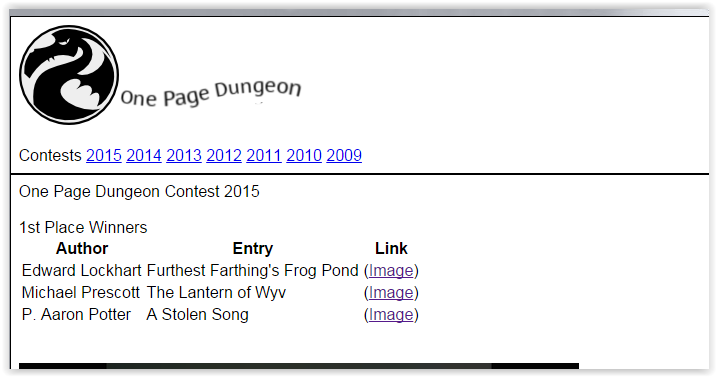The winners of the 2015 One Page Dungeon Contest were announced a few days ago. Check out the 1PDC Google Community.
My entry, The Dire Druids of Delver’s Deep, was not among them. I did not expect to win. I knew that there were many who had massively better entries in look, layout, and more from prior years. My entry was an exercise to see what I could do with an idea.
From what I have seen of the winners of the last couple of years, one needs an idea that is solid and well defined with a great hook. The Artwork needs to be top notch, and the layout has to make it all “flow” and draw the reader into it.
I am curious to watch the recording of the Google Hangout with the judges [Link Broken, no alternative, August, 2017], to see if there are any “simple” dungeons that had ideas they liked, but due to art or layout, did not make the cut. Set aside about 45 minutes if you want to watch it all in one go. I missed the live hangout.
Out of all the submissions, there were 3 first place winners, 6 second place winners, 13 third place winners, and 5 honorable mentions. Based purely on first names in each category, it looks like there is one women in each of the last three categories. This makes 97 new dungeons. Since 2009, seven years, that’s about 700 dungeons. Not all are fantasy, not all are dungeons. Still, that is a lot of ideas if your creative well has ran dry. I like to grab and re-purpose the maps for my own use.
One blogger, +Aaron Frost, of Wasted The Game, is going through all the 1PDC entries and giving his thoughts on them. He has a lot of material.
Daddy Rolled A 1 was a judge last year and again this year. Here is his take on the process.
After watching the hangout video there are a few things one can take away about how to approach this contest.
- The Past and Storytelling are not as important.
- What is going on NOW?
- What situation will the characters encounter when you run it?
- Brief yet Complete.
- Set up well in the beginning with an answer to how does it end/get resolved?
- White space/Imagery/Readable
- The art is not as important as an idea that is presented well.
- Spelling and Grammar – i.e. after you spellcheck and grammar check it, get a proofreader.
- Put enough time into it to do it well.
I know that I had a lot of text. Paring that down to something that “pops” would improve it. That is, express the intent without requiring too much detail.
The hangout mentioned one winning submission that had excellent 2 sentence NPC descriptions that made for NPCs that could be plugged into any campaign.
I would suggest reading through the submissions and learning from them. What did the winners do well? What did the others not do as well that might best be avoided?
One more shout out, +Random Wizard [UPDATE: Random Wizard is no longer on G+. Check out his blog: https://www.kirith.com/random-wizard/] has sold off unused items in his personal collection to ensure that there are prizes for all 13 of the third place winners, a $25 store credit at Wayne’s Books! Talk about a class act! Not only has he given his time to organize the contest, he made sure that third place had prizes out of his own pocket!
There will always be grumblers who complain about things, and complaining is their ONLY “contribution.” It is easy to say that this or that wasn’t right, fair, or the way you would do it. If you are not willing to step up and add something of value to the hobby, why are you tearing down others who are? I don’t know who these complainers are about the 1PDC, they must be ranting on some forum to which I don’t belong. Of that, I am glad. I only know about it, because I saw mention of it on another blog. If the complainers would put forth the energy they spend complaining into making something to share with the others in the OSR, we’d all be better for it. It reminds me of my sons when they complained about doing homework or cleaning their room. If they would have shut up and just done the task at hand, it would have required less energy. Oh well, it is the loss of the complainers. Once we learn what an internet troll is, we know to ignore it, and it becomes as static. It is annoying, but we can learn to tune it out.
I for one am interested to read through the entries. I also am interested in attempting a submission for next year. I may come up with an idea and start working it out to boil it down to the good stuff. Better yet, I’ll take more time on the layout and presentation.





